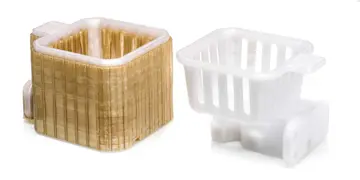3D printing is a manufacturing process that creates a physical object from a digital model file. The technology works by adding layer upon layer of material to build up a complete object.
Introduction to 3D printing
The 3D printing process was devised in the 1980s and originally known as ‘rapid prototyping’. It enabled companies to develop prototypes quickly and more accurately than with other methods. After over 30 years of innovation, its uses are far more diverse today.
Manufacturers, engineers, designers, educators, medics, and hobbyists alike use the technology for a huge range of applications.
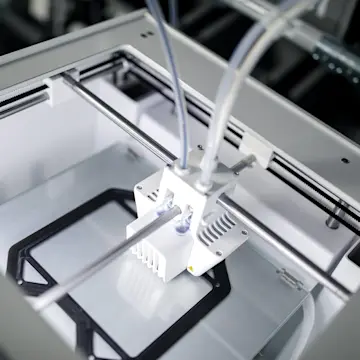

The development of more compact ‘desktop’ 3D printers and their affordable cost have also made the technology increasingly accessible over time.
How does 3D printing work?
As we saw earlier, the 3D printing process involves building up layer upon layer of molten plastic to create an object. As each layer sets, the next layer is printed on top and the object is built up.
To make a 3D print, a digital file is needed that tells the 3D printer where to print the material. The most common file format for this is the G-code files. This file essentially contains ‘coordinates’ to guide the printer’s movements, both horizontally and vertically – also known as the X, Y, and Z axes.
3D printers can print these layers at different thicknesses, known as layer height. A bit like pixels on a screen, more layers in a print will give a higher ‘resolution’. This will give a better-looking result, but take longer to print.
3D printing vs. additive manufacturing?
This adding up of layers gives 3D printing its alternative name – ‘additive manufacturing’.
You will often see the terms used to refer to the same manufacturing process. Additive manufacturing is the opposite of ‘subtractive’ processes where material is removed (or subtracted) from a larger block to create the final object, for example CNC machining.
FDM vs FFF 3D printing – explained
Another thing that may confuse newcomers to 3D printing is seeing references to FDM (fused deposition modeling) and FFF (fused filament fabrication) processes. Again, these are essentially different names for the same thing as they both refer to a specific type of 3D printer.
There are different types of 3D printer? Yes! But no need to be confused – we’ll take a quick look at these next.
What are the different 3D printing technologies?
Plastics are a versatile type of material, and as a result there are many ways of manufacturing with it. 3D printing is no exception, so let’s explore the different methods.
The most widely used technologies are FFF 3D printing, SLA (stereolithography), and SLS (selective laser sintering).
What is FFF 3D printing?
An FFF printer extrudes a thick string of material, commonly referred to as filament, through a heated nozzle. The nozzle is mounted on a motion system that moves it around a build area, where melted filament is deposited onto a build plate. As the material cools and solidifies, the build plate moves down by a fraction of a millimeter layer by layer until the object is complete.

What is SLA 3D printing?
SLA 3D printing uses a UV-curable resin as raw material. The resin is poured into a glass-bottomed container, into which a build platform is submerged. A laser shines UV light on the resin to selectively harden a cross-section of the required shape. The platform gradually raises out of the container to build up the print.
What is SLS 3D printing?
SLS 3D printing uses a powdered raw material, typically a polymer. The powder sits in a container, where a blade distributes a thin layer of material onto the build area. A laser fuses the small particles of material together to form a single horizontal layer of the part, then the container then moves a fraction of a millimeter to start a new layer, and the blade swipes across the build area to deposit a new layer of raw material. This process repeats to create the finished object.
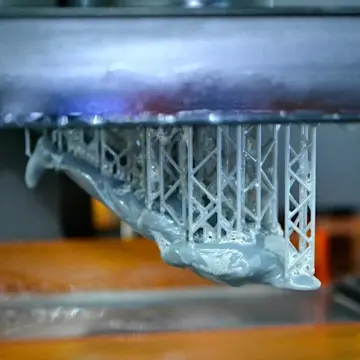
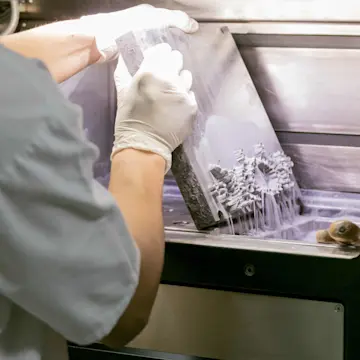
This is by no means an exhaustive list, and you may also come across the following:
-
DLP (direct light processing) – A resin-based process similar to SLA. Instead of a laser curing an individual point of resin at a time, DLP uses light to project an image of the entire layer into the resin
-
Binder jetting – A powder-based process similar to SLS, except that the powder is fused by a binding agent rather than a laser
-
Material jetting – A variation on ‘2D’ inkjet printing that can create 3D parts by depositing wax or plastic material then curing it with UV light
-
SLM (selective laser melting) – One of a few similar variations of SLS technology for metal 3D printing
Want to understand the pros and cons of each technology? Read our in-depth guide comparing 3D printing processes.
What materials are used in 3D printing?
Plastic polymers are the most common material used in 3D printing. Using other materials is possible. For example, there are dedicated metal 3D printers, but these are niche compared to polymer printers. And super-sized machines based on 3D printing technology are starting to be developed for construction materials like concrete.
Mainstream 3D printer types such as FFF and SLS can print blends of polymers and other materials (such as metal, glass, or wood). These are known as composites and offer some of the properties of the blended material.
In the context of FFF 3D printing, you may see the terms ‘3D printing material’ and ‘3D printing filament’ used interchangeably. This is because the raw material comes on spools of thin filament.
In the following sections, we will look at some 3D printing filaments in more detail by category.
Starter 3D printing materials
PLA
Derived from organic, renewable resources and easy to print with, PLA is the go-to beginner’s filament. PLA also has great visual properties. But its low temperature resistance and the fact that mechanical properties can degrade over time mean PLA is often overlooked for functional and mechanical applications.
PETG
A well-balanced mix of properties has seen PETG grow to become one of the most widely used 3D printing materials. It could easily be classed as an 'engineering material', but it's also a good option for beginners thanks to good printability. Combining impact and chemical resistance with good thermal properties, while also being cheaper than many other engineering materials, it’s the go-to filament for engineering applications for many users.
Engineering 3D printing materials
Nylon
Possessing chemical resistance and able to withstand significant mechanical stress, nylon is a versatile option for end-use parts.
ABS
Offering superior mechanical and heat resistance properties compared to PLA, ABS is a material for more demanding applications. However, it can be difficult to print with, especially on a cheaper, open-frame 3D printer. An enclosed build chamber and controlled temperature give a much more reliable experience.

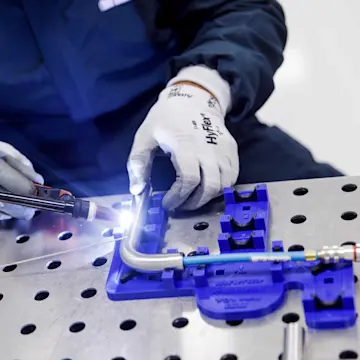
Flexible 3D printing materials
TPU
With its rubber-like properties, TPU can be twisted, stretched, and withstand impacts without problems.
PP
Semi-flexible and fatigue resistant, PP (or polypropylene as you may know it) is ideal for applications that need some flexibility, such as hinges or liquid containers.
Specialist 3D printing materials
Composite materials
These filaments combine a polymer with fibers of another material to give enhanced properties. There are two main categories. Engineering composites including glass, carbon, or metal fibers offer enhanced mechanical properties such as strength and stiffness. And for unique visual properties, there are composite options like ceramic or wood filaments for 3D printing, or even glow-in-the-dark. (Note: the fibers in composite filaments can cause abrasion, so check your printer is compatible before using any).
While they sometimes overlap with the categories above, there are many more specialist 3D printing filaments to discover on the market, such as ESD-safe or flame-retardant materials.
Support materials
First, let’s quickly explain what these are.
Each new layer of a 3D print requires the layer underneath to support it. Issues arise when a print’s design requires an overhang, or an element that’s suspended in mid-air. So these materials literally ‘support’ it during the printing process and are removed after. Supports can be printed with the same material as the rest of the print, but their removal can affect its surface quality and dimensional accuracy. To avoid this, specialized support materials have been developed.
Soluble support material
Soluble support materials are dissolvable, so there is no risk of damaging your part during manual removal. PVA support material dissolves in water, while HIPS requires the solvent d-limonene.
Breakaway
Somewhere between the options mentioned so far, a material like Ultimaker Breakaway is a distinct support material that is manually removed. This makes the process faster than waiting for it to dissolve, while retaining the part’s dimensional accuracy.
